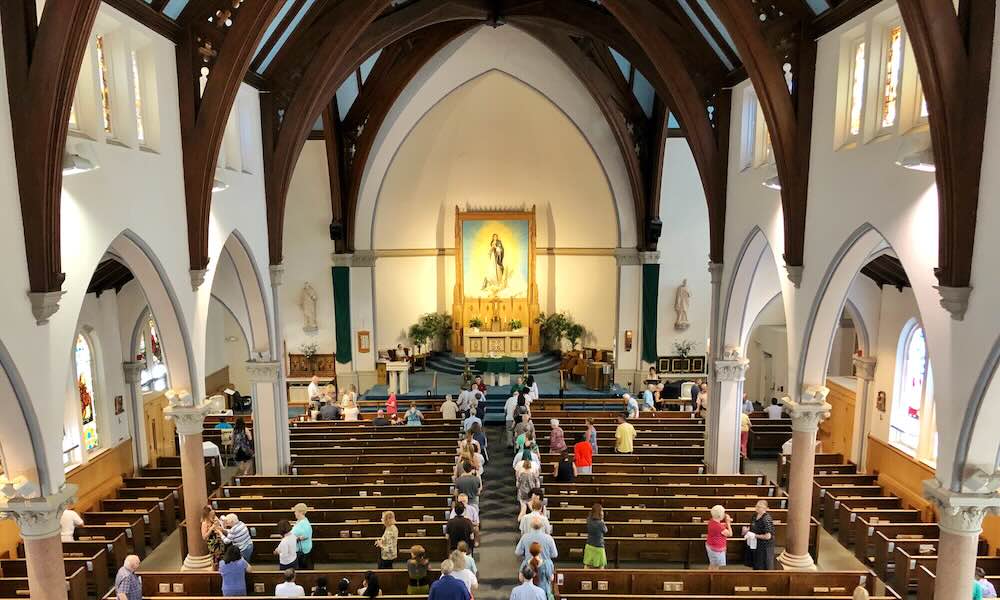Enhancing Church Safety: Policies and Technology
Learn how churches can strengthen safety through effective policies and modern technology. Explore strategies like surveillance systems, child protection protocols, and church software to create a secure, welcoming environment for all.

In a perfect world, we wouldn’t have to worry about church safety. But it’s all too apparent from both the news and Scripture that our world is broken (Romans 8:22). That being said, church safety remains a top priority for many church leaders. When church members, leaders, and volunteers know that they are gathering in an environment where safety is prioritized, they can spend more time concentrating on Jesus, less time on worrying about potential security mishaps.
This article explores how a combination of robust church policies and advanced technology can help churches remain sanctuaries of peace, providing a secure environment for worship and fellowship.
The Importance of Church Safety
Churches serve as gathering places for worship, education, and community outreach, making them essential pillars of society. However, their open and welcoming nature can sometimes make them vulnerable to various safety concerns. From epidemics to human-caused incidents, churches must be prepared to address a wide range of potential threats. Ensuring the safety of church members, especially vulnerable adults, children, and youth, is critical.
Creating a safe church is not just about physical security; it is also about creating an environment where people feel safe to worship and participate in church activities. A well-thought-out safety strategy can help prevent incidents like shootings, vandalism, and sexual abuse, minimize risks, and respond effectively when emergencies occur.
Developing Comprehensive Church Safety Policies
A strong foundation for church safety begins with developing comprehensive church safety policies. These policies should be tailored to the specific needs of the church and its congregation, taking into account factors such as the size of the church, its location, and the types of activities that take place.
- Risk Assessment: Conducting a thorough risk assessment is the first step in developing safety policies. This involves identifying potential hazards, assessing the likelihood of these hazards occurring, and determining the impact they could have on the church community. This assessment should be revisited regularly to account for changes in the church's environment or activities.
- Emergency Preparedness: Churches should have clear and accessible emergency preparedness plans. These plans should cover a range of scenarios, including fire, medical emergencies, active shooter situations, and natural disasters. Regular drills and training sessions for church staff, security teams, and volunteers are essential to ensure everyone knows their role in an emergency.
- Child Safety Policy: For churches that have children and youth ministries, implementing a strong child safety policy is crucial. These policies should include background checks for volunteers and staff, clear guidelines for supervision, and procedures for reporting and responding to any concerns. This is particularly important in preventing sexual abuse and ensuring the safety of minors.
- Health and Safety Protocols: Health and safety protocols have become more important than ever. Churches should establish guidelines for sanitation, social distancing, and mask usage, as well as policies for handling potential outbreaks within the congregation.
- Incident Reporting and Response: A key component of church safety is having a system in place for reporting and responding to incidents. This includes documenting incidents, communicating with local law enforcement when necessary, and providing support to those affected. Church security teams play a vital role in this process, ensuring that any potential threats are managed promptly and effectively.
Leveraging Technology for Enhanced Safety
While strong policies are essential, technology can also play a significant role in church safety. Advances in technology provide churches with tools that can help monitor, protect, and respond to safety concerns more effectively.
- Security Cameras and Surveillance: Installing security cameras is one of the most effective ways to deter criminal activity and monitor the premises. Modern surveillance systems offer high-definition video, remote access, and advanced features such as motion detection and facial recognition, which are critical for monitoring areas like the parking lot.
- Access Control Systems: Implementing access control systems allows churches to regulate who enters specific areas of the building. This can be particularly useful for protecting sensitive areas like offices, nurseries, and storage rooms. Keycards, biometric scanners, and keypad entry systems are all viable options for controlling access.
- Church Software: Clear communication and organization can help security staff and volunteers perform their jobs more effectively. Church software not only helps volunteers and church leaders remain on the same page; it also typically includes tools for child check-in, a key part of church safety.
- Mobile Apps for Safety: Many churches are now utilizing mobile apps to enhance safety. These apps can provide congregation members with real-time information during emergencies, including evacuation routes, emergency contacts, and updates on the situation. Additionally, apps can be used to report suspicious activity or request assistance, contributing to a comprehensive church security program.
- Cybersecurity Measures: As churches increasingly rely on digital tools for administration, communication, and giving, cybersecurity has become a critical aspect of overall safety. Churches must implement strong cybersecurity measures to protect sensitive information, prevent data breaches, and ensure the integrity of their digital platforms. The best church software tools have cybersecurity measures built in.
- Fire Detection and Suppression Systems: Advanced fire detection systems that integrate with sprinkler systems and alert local fire departments can significantly reduce the risk of fire-related damage and injuries. Regular maintenance and testing of these systems are crucial to ensure their effectiveness.
Safety Resources and Support
For churches seeking to enhance their safety strategies, turning to trusted, expert-led resources is crucial. One of the most comprehensive and church-specific safety organizations available today is MinistrySafe. Founded by legal professionals with deep experience in sexual abuse litigation, MinistrySafe offers robust tools and training specifically designed to protect children and vulnerable populations within church environments.
MinistrySafe provides:
- Sexual Abuse Awareness Training for staff, volunteers, and church leaders
- Sample safety policies and procedures tailored for ministry settings
- Background check integration and monitoring services
- Online learning modules for scalable, ongoing education
- Live workshops and webinars covering abuse prevention, reporting requirements, and best practices for church safety
Their resources are built to help churches not only meet legal standards but also cultivate a deeply ingrained culture of safety. Whether you're launching a new child protection policy or updating your existing safety strategy, MinistrySafe offers step-by-step support.
In addition to MinistrySafe, churches can also benefit from collaborating with local law enforcement, regional church associations, and national organizations to stay informed on emerging threats and mitigation strategies.
By tapping into these expert sources, churches can continuously refine their safety plans, ensuring they are well-equipped to protect their congregations while maintaining a welcoming and worship-focused atmosphere.
Building a Culture of Safety
The most effective safety policies and technologies are those that are embraced by the entire church community. Creating a culture of safety involves regular communication and volunteer training. This includes educating the congregation about the safety measures in place, encouraging vigilance, and promoting an environment where everyone feels responsible for the safety of the community.
Church leaders should establish a dedicated church security team comprised of staff and volunteers who oversee the implementation and continuous improvement of safety policies and procedures. This team can serve as a resource for the congregation, answering questions, providing training, and coordinating with local law enforcement and emergency services.
Of course, this also involves encouraging the congregation to pray for protection and look to God for comfort and peace. Though we live in a broken world, we can rest in knowing God as our protector. Feeding anxiety and stress is not the goal; encouraging thoughtfulness and trust is a Bible-centered approach to safety.
Over to You
Enhancing church safety requires a holistic approach that combines thoughtful policies with the latest technology. By proactively addressing potential risks and leveraging technological advancements, churches can create a safe and secure environment for worship, fellowship, and ministry. As we continue to navigate the challenges of modern society, investing in church safety is not just a necessity but a demonstration of care and responsibility towards the congregation, the broader community, and ultimately, to God.
By implementing comprehensive safety measures–including church software–and fostering a culture of vigilance, churches can continue to be places where worship, fellowship, and the teachings of Christ flourish without fear.
Sign Up for Product Updates
In a perfect world, we wouldn’t have to worry about church safety. But it’s all too apparent from both the news and Scripture that our world is broken (Romans 8:22). That being said, church safety remains a top priority for many church leaders. When church members, leaders, and volunteers know that they are gathering in an environment where safety is prioritized, they can spend more time concentrating on Jesus, less time on worrying about potential security mishaps.
This article explores how a combination of robust church policies and advanced technology can help churches remain sanctuaries of peace, providing a secure environment for worship and fellowship.
The Importance of Church Safety
Churches serve as gathering places for worship, education, and community outreach, making them essential pillars of society. However, their open and welcoming nature can sometimes make them vulnerable to various safety concerns. From epidemics to human-caused incidents, churches must be prepared to address a wide range of potential threats. Ensuring the safety of church members, especially vulnerable adults, children, and youth, is critical.
Creating a safe church is not just about physical security; it is also about creating an environment where people feel safe to worship and participate in church activities. A well-thought-out safety strategy can help prevent incidents like shootings, vandalism, and sexual abuse, minimize risks, and respond effectively when emergencies occur.
Developing Comprehensive Church Safety Policies
A strong foundation for church safety begins with developing comprehensive church safety policies. These policies should be tailored to the specific needs of the church and its congregation, taking into account factors such as the size of the church, its location, and the types of activities that take place.
- Risk Assessment: Conducting a thorough risk assessment is the first step in developing safety policies. This involves identifying potential hazards, assessing the likelihood of these hazards occurring, and determining the impact they could have on the church community. This assessment should be revisited regularly to account for changes in the church's environment or activities.
- Emergency Preparedness: Churches should have clear and accessible emergency preparedness plans. These plans should cover a range of scenarios, including fire, medical emergencies, active shooter situations, and natural disasters. Regular drills and training sessions for church staff, security teams, and volunteers are essential to ensure everyone knows their role in an emergency.
- Child Safety Policy: For churches that have children and youth ministries, implementing a strong child safety policy is crucial. These policies should include background checks for volunteers and staff, clear guidelines for supervision, and procedures for reporting and responding to any concerns. This is particularly important in preventing sexual abuse and ensuring the safety of minors.
- Health and Safety Protocols: Health and safety protocols have become more important than ever. Churches should establish guidelines for sanitation, social distancing, and mask usage, as well as policies for handling potential outbreaks within the congregation.
- Incident Reporting and Response: A key component of church safety is having a system in place for reporting and responding to incidents. This includes documenting incidents, communicating with local law enforcement when necessary, and providing support to those affected. Church security teams play a vital role in this process, ensuring that any potential threats are managed promptly and effectively.
Leveraging Technology for Enhanced Safety
While strong policies are essential, technology can also play a significant role in church safety. Advances in technology provide churches with tools that can help monitor, protect, and respond to safety concerns more effectively.
- Security Cameras and Surveillance: Installing security cameras is one of the most effective ways to deter criminal activity and monitor the premises. Modern surveillance systems offer high-definition video, remote access, and advanced features such as motion detection and facial recognition, which are critical for monitoring areas like the parking lot.
- Access Control Systems: Implementing access control systems allows churches to regulate who enters specific areas of the building. This can be particularly useful for protecting sensitive areas like offices, nurseries, and storage rooms. Keycards, biometric scanners, and keypad entry systems are all viable options for controlling access.
- Church Software: Clear communication and organization can help security staff and volunteers perform their jobs more effectively. Church software not only helps volunteers and church leaders remain on the same page; it also typically includes tools for child check-in, a key part of church safety.
- Mobile Apps for Safety: Many churches are now utilizing mobile apps to enhance safety. These apps can provide congregation members with real-time information during emergencies, including evacuation routes, emergency contacts, and updates on the situation. Additionally, apps can be used to report suspicious activity or request assistance, contributing to a comprehensive church security program.
- Cybersecurity Measures: As churches increasingly rely on digital tools for administration, communication, and giving, cybersecurity has become a critical aspect of overall safety. Churches must implement strong cybersecurity measures to protect sensitive information, prevent data breaches, and ensure the integrity of their digital platforms. The best church software tools have cybersecurity measures built in.
- Fire Detection and Suppression Systems: Advanced fire detection systems that integrate with sprinkler systems and alert local fire departments can significantly reduce the risk of fire-related damage and injuries. Regular maintenance and testing of these systems are crucial to ensure their effectiveness.
Safety Resources and Support
For churches seeking to enhance their safety strategies, turning to trusted, expert-led resources is crucial. One of the most comprehensive and church-specific safety organizations available today is MinistrySafe. Founded by legal professionals with deep experience in sexual abuse litigation, MinistrySafe offers robust tools and training specifically designed to protect children and vulnerable populations within church environments.
MinistrySafe provides:
- Sexual Abuse Awareness Training for staff, volunteers, and church leaders
- Sample safety policies and procedures tailored for ministry settings
- Background check integration and monitoring services
- Online learning modules for scalable, ongoing education
- Live workshops and webinars covering abuse prevention, reporting requirements, and best practices for church safety
Their resources are built to help churches not only meet legal standards but also cultivate a deeply ingrained culture of safety. Whether you're launching a new child protection policy or updating your existing safety strategy, MinistrySafe offers step-by-step support.
In addition to MinistrySafe, churches can also benefit from collaborating with local law enforcement, regional church associations, and national organizations to stay informed on emerging threats and mitigation strategies.
By tapping into these expert sources, churches can continuously refine their safety plans, ensuring they are well-equipped to protect their congregations while maintaining a welcoming and worship-focused atmosphere.
Building a Culture of Safety
The most effective safety policies and technologies are those that are embraced by the entire church community. Creating a culture of safety involves regular communication and volunteer training. This includes educating the congregation about the safety measures in place, encouraging vigilance, and promoting an environment where everyone feels responsible for the safety of the community.
Church leaders should establish a dedicated church security team comprised of staff and volunteers who oversee the implementation and continuous improvement of safety policies and procedures. This team can serve as a resource for the congregation, answering questions, providing training, and coordinating with local law enforcement and emergency services.
Of course, this also involves encouraging the congregation to pray for protection and look to God for comfort and peace. Though we live in a broken world, we can rest in knowing God as our protector. Feeding anxiety and stress is not the goal; encouraging thoughtfulness and trust is a Bible-centered approach to safety.
Over to You
Enhancing church safety requires a holistic approach that combines thoughtful policies with the latest technology. By proactively addressing potential risks and leveraging technological advancements, churches can create a safe and secure environment for worship, fellowship, and ministry. As we continue to navigate the challenges of modern society, investing in church safety is not just a necessity but a demonstration of care and responsibility towards the congregation, the broader community, and ultimately, to God.
By implementing comprehensive safety measures–including church software–and fostering a culture of vigilance, churches can continue to be places where worship, fellowship, and the teachings of Christ flourish without fear.
podcast transcript
In a perfect world, we wouldn’t have to worry about church safety. But it’s all too apparent from both the news and Scripture that our world is broken (Romans 8:22). That being said, church safety remains a top priority for many church leaders. When church members, leaders, and volunteers know that they are gathering in an environment where safety is prioritized, they can spend more time concentrating on Jesus, less time on worrying about potential security mishaps.
This article explores how a combination of robust church policies and advanced technology can help churches remain sanctuaries of peace, providing a secure environment for worship and fellowship.
The Importance of Church Safety
Churches serve as gathering places for worship, education, and community outreach, making them essential pillars of society. However, their open and welcoming nature can sometimes make them vulnerable to various safety concerns. From epidemics to human-caused incidents, churches must be prepared to address a wide range of potential threats. Ensuring the safety of church members, especially vulnerable adults, children, and youth, is critical.
Creating a safe church is not just about physical security; it is also about creating an environment where people feel safe to worship and participate in church activities. A well-thought-out safety strategy can help prevent incidents like shootings, vandalism, and sexual abuse, minimize risks, and respond effectively when emergencies occur.
Developing Comprehensive Church Safety Policies
A strong foundation for church safety begins with developing comprehensive church safety policies. These policies should be tailored to the specific needs of the church and its congregation, taking into account factors such as the size of the church, its location, and the types of activities that take place.
- Risk Assessment: Conducting a thorough risk assessment is the first step in developing safety policies. This involves identifying potential hazards, assessing the likelihood of these hazards occurring, and determining the impact they could have on the church community. This assessment should be revisited regularly to account for changes in the church's environment or activities.
- Emergency Preparedness: Churches should have clear and accessible emergency preparedness plans. These plans should cover a range of scenarios, including fire, medical emergencies, active shooter situations, and natural disasters. Regular drills and training sessions for church staff, security teams, and volunteers are essential to ensure everyone knows their role in an emergency.
- Child Safety Policy: For churches that have children and youth ministries, implementing a strong child safety policy is crucial. These policies should include background checks for volunteers and staff, clear guidelines for supervision, and procedures for reporting and responding to any concerns. This is particularly important in preventing sexual abuse and ensuring the safety of minors.
- Health and Safety Protocols: Health and safety protocols have become more important than ever. Churches should establish guidelines for sanitation, social distancing, and mask usage, as well as policies for handling potential outbreaks within the congregation.
- Incident Reporting and Response: A key component of church safety is having a system in place for reporting and responding to incidents. This includes documenting incidents, communicating with local law enforcement when necessary, and providing support to those affected. Church security teams play a vital role in this process, ensuring that any potential threats are managed promptly and effectively.
Leveraging Technology for Enhanced Safety
While strong policies are essential, technology can also play a significant role in church safety. Advances in technology provide churches with tools that can help monitor, protect, and respond to safety concerns more effectively.
- Security Cameras and Surveillance: Installing security cameras is one of the most effective ways to deter criminal activity and monitor the premises. Modern surveillance systems offer high-definition video, remote access, and advanced features such as motion detection and facial recognition, which are critical for monitoring areas like the parking lot.
- Access Control Systems: Implementing access control systems allows churches to regulate who enters specific areas of the building. This can be particularly useful for protecting sensitive areas like offices, nurseries, and storage rooms. Keycards, biometric scanners, and keypad entry systems are all viable options for controlling access.
- Church Software: Clear communication and organization can help security staff and volunteers perform their jobs more effectively. Church software not only helps volunteers and church leaders remain on the same page; it also typically includes tools for child check-in, a key part of church safety.
- Mobile Apps for Safety: Many churches are now utilizing mobile apps to enhance safety. These apps can provide congregation members with real-time information during emergencies, including evacuation routes, emergency contacts, and updates on the situation. Additionally, apps can be used to report suspicious activity or request assistance, contributing to a comprehensive church security program.
- Cybersecurity Measures: As churches increasingly rely on digital tools for administration, communication, and giving, cybersecurity has become a critical aspect of overall safety. Churches must implement strong cybersecurity measures to protect sensitive information, prevent data breaches, and ensure the integrity of their digital platforms. The best church software tools have cybersecurity measures built in.
- Fire Detection and Suppression Systems: Advanced fire detection systems that integrate with sprinkler systems and alert local fire departments can significantly reduce the risk of fire-related damage and injuries. Regular maintenance and testing of these systems are crucial to ensure their effectiveness.
Safety Resources and Support
For churches seeking to enhance their safety strategies, turning to trusted, expert-led resources is crucial. One of the most comprehensive and church-specific safety organizations available today is MinistrySafe. Founded by legal professionals with deep experience in sexual abuse litigation, MinistrySafe offers robust tools and training specifically designed to protect children and vulnerable populations within church environments.
MinistrySafe provides:
- Sexual Abuse Awareness Training for staff, volunteers, and church leaders
- Sample safety policies and procedures tailored for ministry settings
- Background check integration and monitoring services
- Online learning modules for scalable, ongoing education
- Live workshops and webinars covering abuse prevention, reporting requirements, and best practices for church safety
Their resources are built to help churches not only meet legal standards but also cultivate a deeply ingrained culture of safety. Whether you're launching a new child protection policy or updating your existing safety strategy, MinistrySafe offers step-by-step support.
In addition to MinistrySafe, churches can also benefit from collaborating with local law enforcement, regional church associations, and national organizations to stay informed on emerging threats and mitigation strategies.
By tapping into these expert sources, churches can continuously refine their safety plans, ensuring they are well-equipped to protect their congregations while maintaining a welcoming and worship-focused atmosphere.
Building a Culture of Safety
The most effective safety policies and technologies are those that are embraced by the entire church community. Creating a culture of safety involves regular communication and volunteer training. This includes educating the congregation about the safety measures in place, encouraging vigilance, and promoting an environment where everyone feels responsible for the safety of the community.
Church leaders should establish a dedicated church security team comprised of staff and volunteers who oversee the implementation and continuous improvement of safety policies and procedures. This team can serve as a resource for the congregation, answering questions, providing training, and coordinating with local law enforcement and emergency services.
Of course, this also involves encouraging the congregation to pray for protection and look to God for comfort and peace. Though we live in a broken world, we can rest in knowing God as our protector. Feeding anxiety and stress is not the goal; encouraging thoughtfulness and trust is a Bible-centered approach to safety.
Over to You
Enhancing church safety requires a holistic approach that combines thoughtful policies with the latest technology. By proactively addressing potential risks and leveraging technological advancements, churches can create a safe and secure environment for worship, fellowship, and ministry. As we continue to navigate the challenges of modern society, investing in church safety is not just a necessity but a demonstration of care and responsibility towards the congregation, the broader community, and ultimately, to God.
By implementing comprehensive safety measures–including church software–and fostering a culture of vigilance, churches can continue to be places where worship, fellowship, and the teachings of Christ flourish without fear.
VIDEO transcript
In a perfect world, we wouldn’t have to worry about church safety. But it’s all too apparent from both the news and Scripture that our world is broken (Romans 8:22). That being said, church safety remains a top priority for many church leaders. When church members, leaders, and volunteers know that they are gathering in an environment where safety is prioritized, they can spend more time concentrating on Jesus, less time on worrying about potential security mishaps.
This article explores how a combination of robust church policies and advanced technology can help churches remain sanctuaries of peace, providing a secure environment for worship and fellowship.
The Importance of Church Safety
Churches serve as gathering places for worship, education, and community outreach, making them essential pillars of society. However, their open and welcoming nature can sometimes make them vulnerable to various safety concerns. From epidemics to human-caused incidents, churches must be prepared to address a wide range of potential threats. Ensuring the safety of church members, especially vulnerable adults, children, and youth, is critical.
Creating a safe church is not just about physical security; it is also about creating an environment where people feel safe to worship and participate in church activities. A well-thought-out safety strategy can help prevent incidents like shootings, vandalism, and sexual abuse, minimize risks, and respond effectively when emergencies occur.
Developing Comprehensive Church Safety Policies
A strong foundation for church safety begins with developing comprehensive church safety policies. These policies should be tailored to the specific needs of the church and its congregation, taking into account factors such as the size of the church, its location, and the types of activities that take place.
- Risk Assessment: Conducting a thorough risk assessment is the first step in developing safety policies. This involves identifying potential hazards, assessing the likelihood of these hazards occurring, and determining the impact they could have on the church community. This assessment should be revisited regularly to account for changes in the church's environment or activities.
- Emergency Preparedness: Churches should have clear and accessible emergency preparedness plans. These plans should cover a range of scenarios, including fire, medical emergencies, active shooter situations, and natural disasters. Regular drills and training sessions for church staff, security teams, and volunteers are essential to ensure everyone knows their role in an emergency.
- Child Safety Policy: For churches that have children and youth ministries, implementing a strong child safety policy is crucial. These policies should include background checks for volunteers and staff, clear guidelines for supervision, and procedures for reporting and responding to any concerns. This is particularly important in preventing sexual abuse and ensuring the safety of minors.
- Health and Safety Protocols: Health and safety protocols have become more important than ever. Churches should establish guidelines for sanitation, social distancing, and mask usage, as well as policies for handling potential outbreaks within the congregation.
- Incident Reporting and Response: A key component of church safety is having a system in place for reporting and responding to incidents. This includes documenting incidents, communicating with local law enforcement when necessary, and providing support to those affected. Church security teams play a vital role in this process, ensuring that any potential threats are managed promptly and effectively.
Leveraging Technology for Enhanced Safety
While strong policies are essential, technology can also play a significant role in church safety. Advances in technology provide churches with tools that can help monitor, protect, and respond to safety concerns more effectively.
- Security Cameras and Surveillance: Installing security cameras is one of the most effective ways to deter criminal activity and monitor the premises. Modern surveillance systems offer high-definition video, remote access, and advanced features such as motion detection and facial recognition, which are critical for monitoring areas like the parking lot.
- Access Control Systems: Implementing access control systems allows churches to regulate who enters specific areas of the building. This can be particularly useful for protecting sensitive areas like offices, nurseries, and storage rooms. Keycards, biometric scanners, and keypad entry systems are all viable options for controlling access.
- Church Software: Clear communication and organization can help security staff and volunteers perform their jobs more effectively. Church software not only helps volunteers and church leaders remain on the same page; it also typically includes tools for child check-in, a key part of church safety.
- Mobile Apps for Safety: Many churches are now utilizing mobile apps to enhance safety. These apps can provide congregation members with real-time information during emergencies, including evacuation routes, emergency contacts, and updates on the situation. Additionally, apps can be used to report suspicious activity or request assistance, contributing to a comprehensive church security program.
- Cybersecurity Measures: As churches increasingly rely on digital tools for administration, communication, and giving, cybersecurity has become a critical aspect of overall safety. Churches must implement strong cybersecurity measures to protect sensitive information, prevent data breaches, and ensure the integrity of their digital platforms. The best church software tools have cybersecurity measures built in.
- Fire Detection and Suppression Systems: Advanced fire detection systems that integrate with sprinkler systems and alert local fire departments can significantly reduce the risk of fire-related damage and injuries. Regular maintenance and testing of these systems are crucial to ensure their effectiveness.
Safety Resources and Support
For churches seeking to enhance their safety strategies, turning to trusted, expert-led resources is crucial. One of the most comprehensive and church-specific safety organizations available today is MinistrySafe. Founded by legal professionals with deep experience in sexual abuse litigation, MinistrySafe offers robust tools and training specifically designed to protect children and vulnerable populations within church environments.
MinistrySafe provides:
- Sexual Abuse Awareness Training for staff, volunteers, and church leaders
- Sample safety policies and procedures tailored for ministry settings
- Background check integration and monitoring services
- Online learning modules for scalable, ongoing education
- Live workshops and webinars covering abuse prevention, reporting requirements, and best practices for church safety
Their resources are built to help churches not only meet legal standards but also cultivate a deeply ingrained culture of safety. Whether you're launching a new child protection policy or updating your existing safety strategy, MinistrySafe offers step-by-step support.
In addition to MinistrySafe, churches can also benefit from collaborating with local law enforcement, regional church associations, and national organizations to stay informed on emerging threats and mitigation strategies.
By tapping into these expert sources, churches can continuously refine their safety plans, ensuring they are well-equipped to protect their congregations while maintaining a welcoming and worship-focused atmosphere.
Building a Culture of Safety
The most effective safety policies and technologies are those that are embraced by the entire church community. Creating a culture of safety involves regular communication and volunteer training. This includes educating the congregation about the safety measures in place, encouraging vigilance, and promoting an environment where everyone feels responsible for the safety of the community.
Church leaders should establish a dedicated church security team comprised of staff and volunteers who oversee the implementation and continuous improvement of safety policies and procedures. This team can serve as a resource for the congregation, answering questions, providing training, and coordinating with local law enforcement and emergency services.
Of course, this also involves encouraging the congregation to pray for protection and look to God for comfort and peace. Though we live in a broken world, we can rest in knowing God as our protector. Feeding anxiety and stress is not the goal; encouraging thoughtfulness and trust is a Bible-centered approach to safety.
Over to You
Enhancing church safety requires a holistic approach that combines thoughtful policies with the latest technology. By proactively addressing potential risks and leveraging technological advancements, churches can create a safe and secure environment for worship, fellowship, and ministry. As we continue to navigate the challenges of modern society, investing in church safety is not just a necessity but a demonstration of care and responsibility towards the congregation, the broader community, and ultimately, to God.
By implementing comprehensive safety measures–including church software–and fostering a culture of vigilance, churches can continue to be places where worship, fellowship, and the teachings of Christ flourish without fear.



















.jpg)

.jpg)






